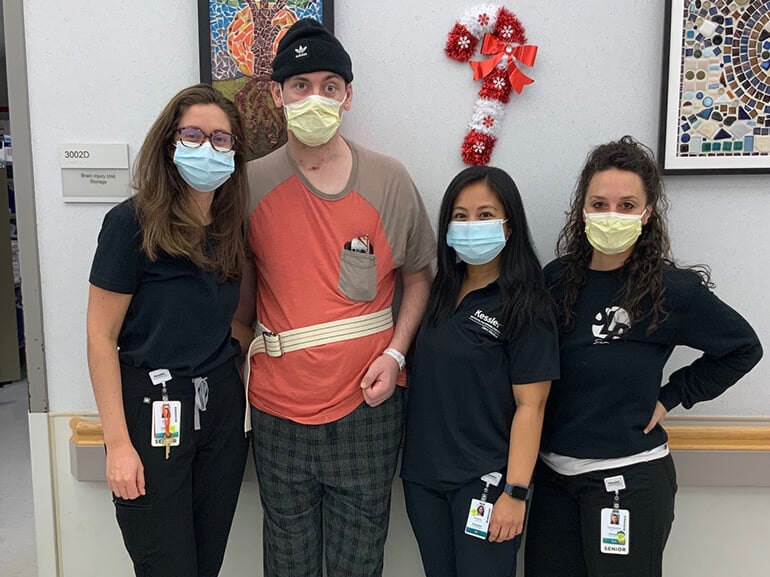Jonathan's story

Dirt biking is Jonathan ‘Jon’ Schimpf’s favorite hobby -- he had been riding for years. But a crash left the experienced rider with a traumatic brain injury and internal trauma.
The biker was taken to the Guthrie Robert Packer Hospital; no one knew just how long the 35-year-old web developer lay unconscious. The medical team in the ER immediately intubated Jon and categorized him a “five” on the Glasgow Coma Scale (GCS). GCS is a universal scale that measures the severity of a brain injury from 0-15, the lower the number, the worse the injury.
Jon’s condition was extremely severe.
A CT scan revealed damaged blood vessels that bled inside and around his brain. Jon was diagnosed with subdural hematoma, a pooling of blood that pushes on the brain. Lifesaving surgery ensued to drain the blood and cerebral spinal fluid to relieve the pressure.
Jon’s hospital stay was complicated by pneumonia and a severe infection related to surgery called pseudomonas meningitis. On top of that, he developed paroxysmal sympathetic storming – a neurological disorder often following a traumatic brain injury. It caused episodes of increased heart rate and blood pressure, excessive sweating, hyperthermia, and involuntary movement of his arms and legs.
After a two month hospital stay, Jon and his family chose Kessler Institute for Rehabilitation – West Orange for its disorders of consciousness program and expertise in treating brain injured patients.
Upon admission to Kessler, Jon faced various physical, functional and cognitive deficits. He was unable to move, communicate his needs, eat or drink. He required assistance for all daily activities. Additionally, his therapist said he “was not following commands or visually tracking people.”
Kessler’s team of brain injury specialists developed an individualized treatment plan for Jon combining medical care and therapies to address his unique needs and goals.
To improve his strength, balance and mobility, Jon’s physical therapists employed a range of technology supported exercises. He undertook high-intensity gait training with a weight-supported treadmill and robotic exoskeleton-- a wearable device that allows patients with lower extremity paralysis or weakness to stand and walk. With persistence and determination, Jon progressed from a wheelchair to standing and, eventually, walking with assistance.
Jon’s occupational therapists focused on positioning strategies and building his core and upper body strength to support transfers from a bed to sitting and standing positions. They also worked to improve his arm and hand function using electrical stimulation – low-level electrical impulses applied to the muscle to build strength and prevent atrophy. To address Jon’s right spatial neglect – the inability to respond to stimuli on one side of the body – his team implemented Kessler Foundation Prism Adaptation therapy (kf-PAT protocol), an innovative treatment in which goggles equipped with optical prisms prompted an increase in the use of his left arm and hand.
Jon’s persistence paid off. He slowly started to get in and out of bed, dress and shower on his own.
In the meantime, speech therapists were at work helping Jon improve his ability to swallow and communicate. He underwent a videofluoroscopic swallowing study which x-rayed Jon’s mouth and throat while he was eating and drinking. The study provided therapists with a road map for safely introducing solids and liquids to Jon’s diet. With that, therapists slowly introduced Jon to thicker nutrients and communication exercises all of which improved his ability to eat, drink and communicate.
“Toward the end of his stay at Kessler, he began to work on using his cellphone and laptop and even negotiate stairs and practicing car transfers,” his therapist said.
He was even able to share some kind words about his care team.
“Do you know what’s not cool? Getting a traumatic brain injury,” Jon said. “But the folks at Kessler hospital helped me relax and be myself during recovery.”
“The head injury took a toll on me,” he stated. “They also made me push myself during my healing, which was intense - but also necessary.”
After two months of rigorous rehabilitation, Jon’s family was happy with his progress.
Eager to return home and to work, he was discharged with family and planned to continue to regain his independence through in-home and outpatient therapy.